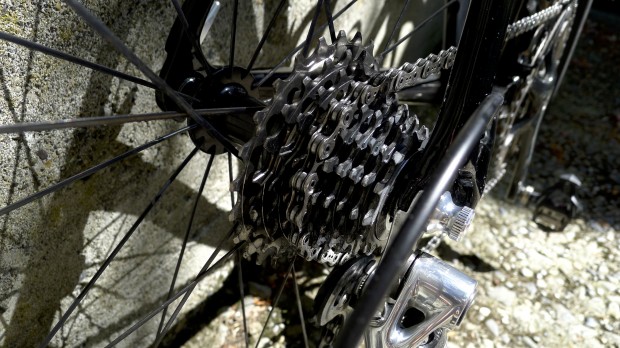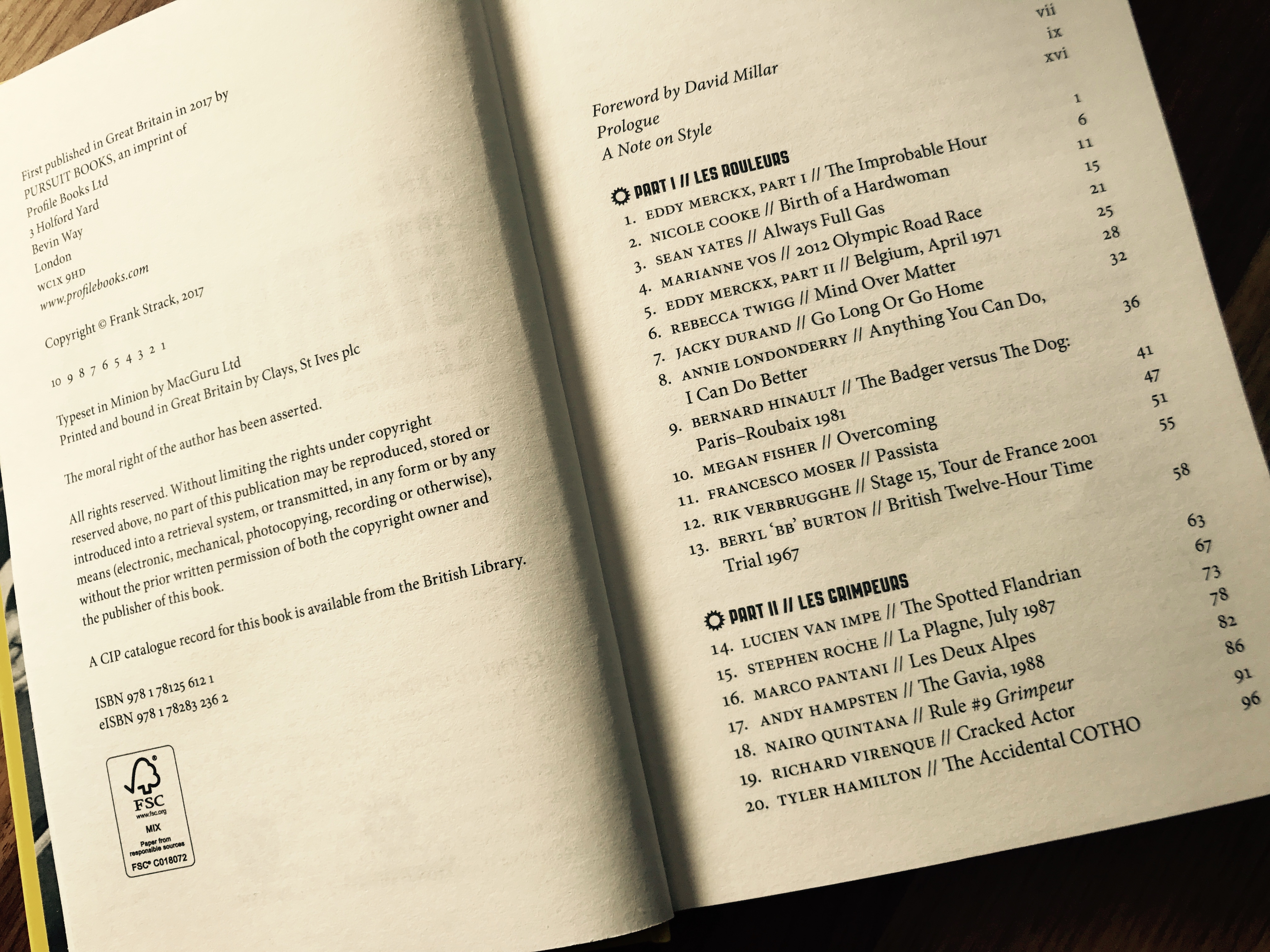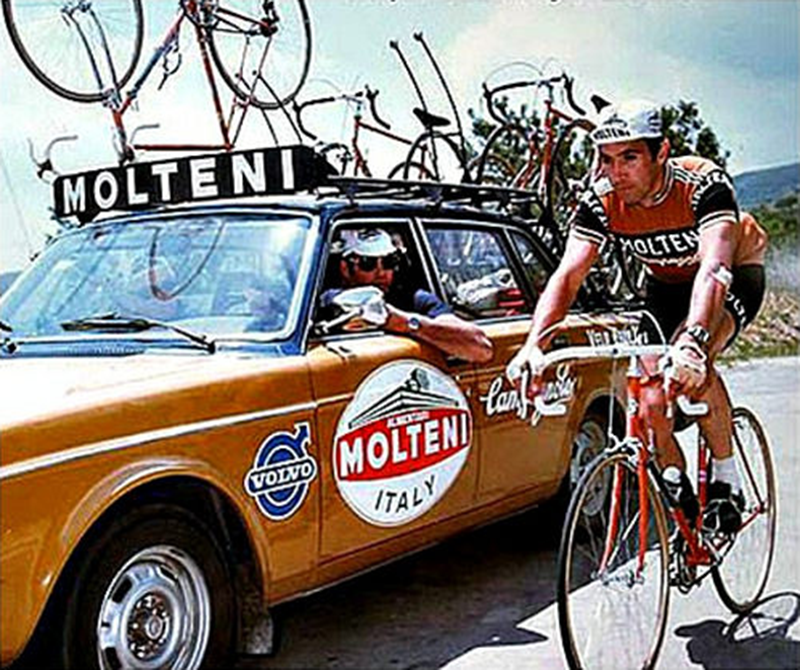Les Choix

I’ve never been able to decide if choices are a gift or a curse; a lack of choices introduces simplicity but also with it the risk that the simple choices do not meet the demands of a complex world. An abundance of similar choices, on the other hand, often reduces the impact of getting things a little bit wrong, but also decreases the thoughtfulness in decision making. Finally, having many divergent choices mostly just leads to a lot of planning and ultimately indecision, assuming my experience in Corporate America is anything to go by.
These days, we tend to ride bicycles with 10 or 11 speed clusters made up of sprockets that are closely matched to their neighbors. This development removes the rider somewhat from the art of gear selection, a fact carried further by bar-mounted shifters; as gradients increase and decrease, we glide from gear to gear maintaining our cadence with hardly any consideration given to the ratios hard at work for us. It is a beautiful freedom to ride like this, but it is also another degree of separation between rider and machine.
I recently read an interview with Sean Kelly, who was discussing his defeat at the hands of Greg Lemond during the 1989 World Championship Road Race. With only seven sprockets at his disposal over a route slightly too hilly for a rider of his ilk, he was faced with a difficult choice: spare the legs on the climb with a 25T at the bottom end, or hamper his sprint with a 13T at the top end.
Kelly faced a tough decision: mount a gear that would carry him over the climb to contend the finale with the handicap of a 13T, or overload the cannons on too big a gear for the climb and never have the chance to go for the win in the first place. He deliberated over the decision while training on the course and finally decided for the low gear. Kelly made it over the climbs to contest the sprint, but his 53×13 was hopelessly outmatched by LeMan’s monster 54×12.
More recently, the Cycling world was aflutter about Tony Martin’s choice to ride a 58T front chain ring during a time trail. This wasn’t a display of bravado but rather a highly refined choice of chain line: knowing the speeds he wanted to ride, he chose his big ring in such a size that would provide the straightest chain line in the gear he’d be riding in during the majority of the race. The result was less friction, and a Tour de France stage win under his belt.
There is an art to gear and cluster choice that is nearly lost with today’s expanding sprocket ranges, but it remains within our grasp if only we are willing to seek it out. Don’t settle for knowing the maximum and minimum size gears in your block; know exactly which gears you have across the board, and understand what sizes you’ll be missing and gaining when switching between 11-23, 12-25 and 13-26 – there is more to it than just taking one off one end and slapping it on the other.
It might not make any material difference to your Cycling, but it will show the quality of your character.


This TED talk is enlightening.
Executive summary: we want choice, and choice makes us unhappy. We synthesize Happy in our brains, and choice just fucks up that process. Boom.
Will I continue to choose choice over no-choice? Fuck yes. Boom boom.
I have an 11-23 on every bike except my dirt racer, which has an 11-28. I went with this because I had some slip issues trying to force the 23 up a hill.
I would want my cassette to almost always have 12-13-14-15-16t cogs. The next five cogs up would be determined by terrain and fitness. Frank, you will be glad to know I am no longer riding the F’d up cassette, as you called it.
Too much choice causes paralysis. In almost any field, a true hallmark of a pro is the ability to distill myriad choices into a few cohesive options that they can act on quickly.
That of course means that I dither endlessly over the smallest, most insignificant details imaginable as they relate to my machines. OCD at its finest.
Just put a 12-13-14-15-17-19-21-23-25 (yes, 9 speed) on the gravel bike. This may not seem all that interesting until you consider the the 53/42 crankset. Haven’t had the chance to ride it yet but am looking forward to it.
A good cassette should have as much of a straight block as possible and not more than 2-tooth gaps on the big cogs.
@marko
I’m tempted to be a smart-ass, but I’ll clamp down on that and ask a purely geographical question, purely in the interest of science. What’s the topography like in that part of MN?
@Nate
Biding my time in the next month or so to blend 2 Campa cassettes together to create an 11-20 10s straight block. Remove 3 sprockets off the back and first position sprocket off the front, then push 11, 12, 13, 14 on the front. The 21 here is an individual sprocket.
52/42 polished record rings.
I want the most efficient gear for the circumstances I’m cycling in. Ergo, whatever it takes. Blanket recommendations be damned.
@uptitus Efficiency is adaptating to the gears you decide to mount.
It used to be easy in the 80s with my Shimano EX 6 speed (or was that 7), just change whatever cog you want. I used to change the 17 a bit as I often spun around in that. Need a get out of jail gear for a climbing challenge? drop in a 28 dinner plate.
i think a lot of modern cyclists don’t realise two things:
1) there are often lots of cross over gears. Back in the day we had the “gear inch” chart taped to our bars so we knew where the next progression was and how big the jump was.
2) crossing your chain is bad. How many times do you see people in small front, small rear? Even SRAM encourage it with their 22.
Adaptating is a word you know.
So, I just threw away two of the three chainrings on my mtb, along with the associated impedimenta. I did it because I’ve got a fucking arthritic left thumb (decades of making it feel like someone else). I thought it was going to be a big sacrifice, but it wasn’t. It appears that I can adapt to a slower cadence and be “Happy” [cue Keith Richards].
*adaptate
@Rom
Keeping the drivetrain clean will also let the chain talk to you to let you know you’re cross chaining. 3rd sprocket to the front or back is the limit.
@unversio The bike is like a piece of clothing. It should fit the cyclist. Same for gearing. Choose the best fit to start with, adapt from there if needed.
@PeakInTwoYears
*adaptated *adaptationally
@uptitus Agree whole heartionally. Only the cyclist may elect to gear up or down.
Yes, agree completionally. And by extending the root word “completion,” I mean to imply no reference to the idea of ejaculation. And by using the word “root,” well, yeah.
It is “comforting” to know you can change a cassette on the spot if needed once you arrive to a race or ride with unexpected terrain.
@unversio
Had some chain length issues swapping from 11-23 to 11-25, in 11 speed, not helped by running the lame 52-36 up front, love the straight block 11-19, 21, 23, which I run on my 404’s, the 11-25 is on the C24’s for climbing rides.
@piwakawaka
Started buying up readily available 13-26 cassettes to blend and create a supply of 11-21 10s clusters. Then selling the *new* 23-26 spider and 13 first position on Ebay to make the deal even better.
@PeakInTwoYears Good question but not a complete question. The answer is undulating. Somewhere between flat and rolling in my immediate riding area. I often find myself riding in rolling to hilly terrain a little further south on the North Shore of Superior. But just as important is the surface. There’s a solid 10-20 percent increase in rolling resistance I’d guesstimate on gravel depending on how packed it is. This has to be accounted for in cassette choice. I found myself crosschained a lot with an 11-23 which is what I ride on the road. Either crossed on big/big for flat cruising or little/little for soft gravel and moderate climbs. 12-25 is not uncommon for cx and neither is a compact. My feeling is with a Belgian standard and a 12-25 cassette I’ll be crossed less. A 53/17ish should be about right for most flats cruising and I’m really hoping something like a 42/19 will be my go to for climbs and softer stuff.
I like Tony Martins way of thinking as I think the same. This is then is reason I long for a 36-52. Strangely enough, SRAM make a 11 speed 36, but no outter ring to suit it….
@PeakInTwoYears “Free your mind…”
11-12-13-14-16-18-20-22-26-28-32 x 50. Could do with a bigger ring.
More gears, not so much choice. Used to tear down the Regina freewheel to put in the cogs I wanted. Kept a straight block on hand for a quick change for the crits. Changed out a chainring and cog to get as close as I could to the 78 inch-gear for winter roller races. But I don’t care to go back to the six and seven speeds and fiddling with the down tube shifter to get the gear just right. Call me soft.
@PeakInTwoYears
I went over and did the Heck of the North in September, as you probably know. People were pissing themselves over this climb called the Seven Bridges in Duluth. Fearsome beast of a climb, the rumors had it.
Rode it in my 50×16 at a casual chatting pace. (And no, my graveur does not have a compact; it is an artisian’s choice of 50/38. )
@Nate
Yes, which is why I prefer the 13-26 over the 12-27 when I need a low gear; you lose the 18 when you move from 12-15 to 13-26 but at least the gears are close enough to make for nice smooth transitions.
And when I’m bombing a hill, you just spin a little harder. 145 is my max so far.
@antihero
A perfect post. Insight balanced by reckless submission to impulse. You, sir, are a scholar and a gentleman.
@mauibike
Actually, that cassette of yours partly inspired this conversation, and those abominations were rather prominent in the French Alps in the late 80’s and early 90’s – on 7 speed blocks, no less. A few good gears for fast stuff and a few good gears for climbing. Just pray you don’t fall in the mid range at any point.
@unversio
I love your approach to Campa cassettes, but I have to question it as well. A 10spd straight block actually decreases the ratio between gears and you go up; each gear is relatively less hard. Which is very Rule #5 but also insane.
I believe the 11-23 on a 53/42 is the equivalent of a straight block on a 7 speed cluster. But I could be wrong.
@PeakInTwoYears
If you were Tinker Juarez, you would have thrown away the two smaller ones and kept the big one.
@unversio
The VMH is a big fan of those, let me know the next time you have a 23-26 laying around.
My favorite block around here is the 12-15.
@unversio
I’m a habitual crosser – never little-little, but I do ride over as far as the 53×23 on my 25 block. My rule is to stay 2 cogs from the left when possible.
On the CX bike, I cross completely and am just resigned to chucking out chains and blocks as needed, but I’ll be fucked if I’m chaining to the 38 just for a 20 meter ramp. I’m not afraid of 40rpm; its good for traction.
@frank Just my trial by error method. Want to see how much I like making 11-20 clusters from a 14-23.
@frank
It’s like pissing all over the toilet seat and floor — no need to go astray.
I’ve said too much.
I try and caution riders in my Club about cross chaining to no avail. These young one just don’t get it. I rode a 5 speed corn cob in the 80’s, and I have to say I an very happy with my Super record 11 speed 12-25 these days.
@EBruner
And the compacts add to the whole problem, in my opinion. Seems like while they offer a good low end and decent top end, the chain is always laying in some horrible line across the bike.
My favorite is a 50km route where I can leave it in the 16 and just shift between 53 and 39.
@G’rilla
What madness is this?
“Too many choices is no choice at all.” Someone else probably said it first but I’m going with Negativland (Cityman, from the album Free).
Riding fixed has left me lazy about shifting and cadence, something I need to work on. I’ll go out for 100km on a geared bike and realize later I only used three cogs. Maybe four or five if there were serious climbs. When I ride the same routes fixed, choice and gearing is reduced to a simple equation: how much I can suffer on the climbs ≠how fast I can spin on the descents.
@frank
heheheee. Brilliant.
@frank
Sorry, I have to say that is crap. I’ve never heard this line of thinking in many years of cycling. I don’t cross on the extreme ends but anything else is fair game. What wears chains out is bad lubrication and what wears out the cassette is bad chains.
All this talk of choice makes realise why i love my SingleSpeed road bike so much. I’m currently running 50/17 with a 50/14 fixed option for the local 10mile TTs.
Just #HTFU and pedal, the simplicity is what makes the experience so pleasureable.
@Gianni
A-Merckx!.. Rule #90 – it’s there for a reason!
When I took delivery of my hand-built Claud Butler ‘All-rounder’ model in 1954 (!) it was fitted with a single 46T Williams chainring with 6.5″ cranks driving a 14 – 18 – 22 Regina block (with only 3 sprockets we didn’t call it a cassette!). The rear derailleur was a Cyclo Benelux. I thought having three gears was the dog’s bollocks at the time. Having fewer gears than the number of fingers on one hand certainly promoted clear cut decision making. You guys with 11 speed cassettes and double chainrings must be spectacles of indecision!
@sowtondevil
Are you saying you’ve not ridden anything else in 50 years ?